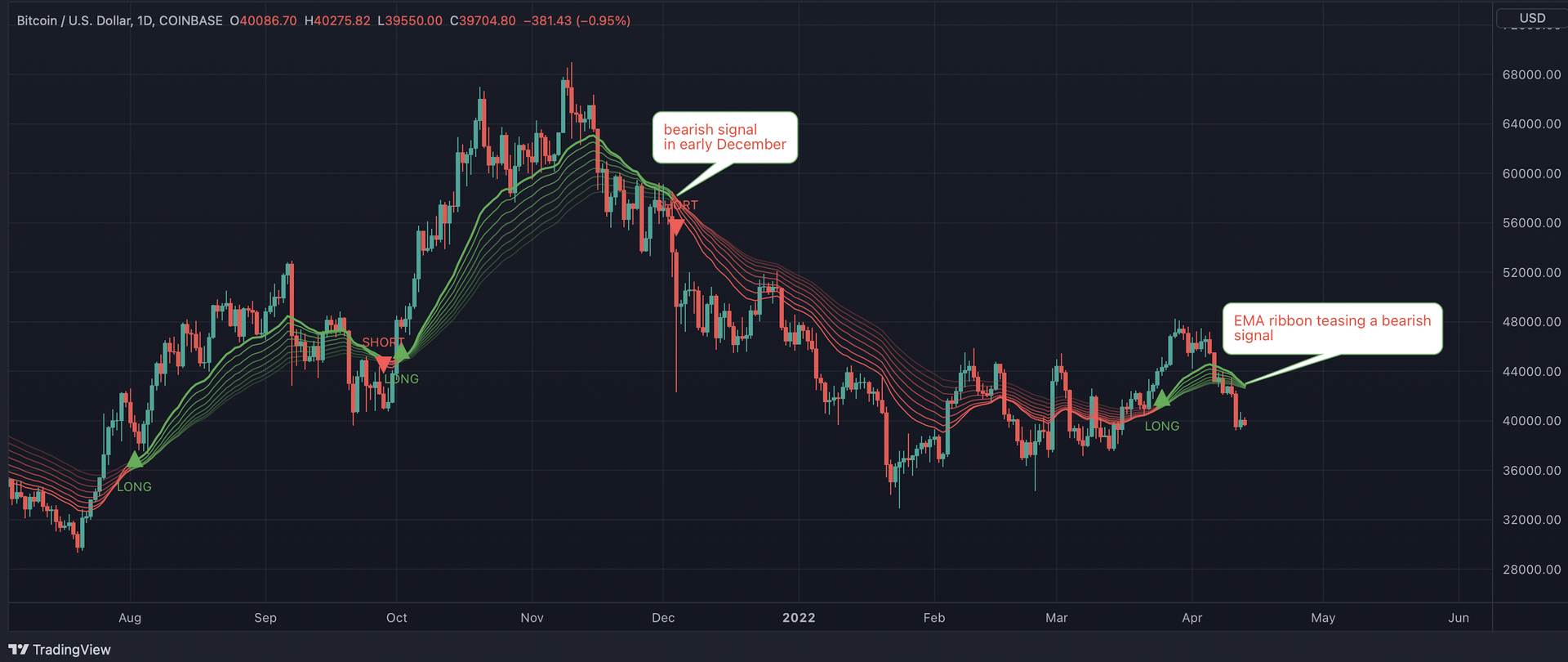First Mover Americas: Bitcoin’s 4-Year Halving Cycle May Be Dead

The latest moves in crypto markets in context for April 13, 2022.
Good morning, and welcome to First Mover, our daily newsletter putting the latest moves in crypto markets in context. Sign up here to get it in your inbox each weekday morning.
Here’s what’s happening this morning:
- Market Moves: Bitcoin is steady as the race among central banks to hike interest rates heats up.
- Featured Story: Bitcoin’s halving-induced four-year cycle may be dead.
And check out the CoinDesk TV show “First Mover,” hosted by Christine Lee, Emily Parker and Lawrence Lewitinn at 9 a.m. U.S. Eastern time.https://imasdk.googleapis.com/js/core/bridge3.510.0_en.html#goog_123431554
- Paul Brody, principal and global innovation leader, EY
- Ethan Lou, author of “Once a Bitcoin Miner”
- Mike Schwitalla, head of trading, Crypto Finance
Market Moves
By Omkar Godbole
Bitcoin (BTC) continued to trade sideways at around $40,000 as the dollar index resumed the uptrend, and the race among central banks to hike interest rates intensified.
The Reserve Bank of New Zealand raised the benchmark rate by 50 basis points to 1.5% during the Asian trading hours, delivering its fourth hike in a row. The case for a 50 basis points interest rate hike from the U.S. Federal Reserve next month has strengthened in the wake of Tuesday’s hotter-than-expected inflation data report. The Bank of Canada is also due for a similar oversized move later this week while the European Central Bank is expected to raise borrowing costs four times within a year, according to Bloomberg.
With so much tightening in the pipeline, the path of least resistance for risk assets, including cryptocurrencies, appears to be on the downside. Bitcoin and ether (ETH) options markets are seeing renewed put bias. A put option gives protection against bearish moves.
From a technical analysis point of view, bitcoin looks weak, with the averages in the exponential moving average (EMA) ribbon converging for an eventual bearish signal similar to the one produced before the early December slide.
The cryptocurrency’s inability to chart gains following Tuesday’s weaker-than-expected core inflation data may be a cause for concern for the bulls. Experts had called the core consumer price index (CPI) data bullish.

Bitcoin’s Halving-Induced 4-Year Cycle Might Be Dead
By Omkar Godbole
Amid the Fed-induced gloom and doom, some investors are betting that history will repeat itself with animal spirits returning to the bitcoin market in the lead up to and following the mining reward halving due in less than two years. However, observers suggest otherwise.
“BTC [at] $43,000 is pricey for a halving that’s two years away, it’s simple fundamentals let the price sink for a while,” one market participant tweeted early this month, while another Twitter handle expressed excitement after noting bitcoin’s record of charting meteoric rallies after reward halving.
To the uninitiated, bitcoin’s mining reward halving is a programmed code to reduce the pace of supply expansion by 50% every four years. Essentially, the cryptocurrency’s monetary policy is on a preset tightening path contradictory to the ever-increasing fiat money supply. That’s one of the main reasons the crypto community considers bitcoin a digital gold and an alternative to the U.S. dollar. The impending halving in 2024 will reduce the per block reward from 6.25 BTC to 3.125 BTC.
Historically, the halving cycle has comprised a two-year recovery rally ahead of the event, followed by a year-long meteoric run and a 12-month bear market. If the past is a guide, 2021 was supposed to be a bullish year like 2017; bears are to control price action this year, paving the way for a recovery rally next year and a bull run after the 2024 halving.
However, the bull cycle is unlikely to repeat itself, according to Katie Talati, director of research at Arca. “There are a couple of reasons; the first is that the power of miners has diminished greatly since the last halving,” Talati told CoinDesk in a Zoom call. “There is just so little bitcoin being released right now. Back in 2018, the narrative was much more driven by miner influence. That’s not the case anymore.”
Glassnode data shows the 30-day average of the number of bitcoin minted currently stands at 900 BTC, worth $35 million – that’s just 0.14% of bitcoin’s 24-hour trading volume of $24.7 billion. The average stood at over 12,000 BTC 10 years ago, above 4,000 BTC between 2013 and 2016, and above 2,000 BTC before 2020.
Besides, with the availability of miner financing facilities, miners no longer need to sell their rewards or coins received for validating transactions on the blockchain to fund their operations, as was the trend in the early days.
“The 2021 migration of hashrate to North America accelerated this change by improving miners’ access to sophisticated financing options. The growing number of listed bitcoin mining companies has further boosted access to capital markets,” CoinDesk’s sister company Genesis Global Trading said in a daily newsletter dated Dec. 27. “With greater funding availability, miners no longer need to sell BTC to fund operations and expansion. This reduces the selling pressure in the market.”
Pipe, a trading platform and technology company valued at $2 billion last year, recently announced a launch of an alternative financing product for bitcoin mining hardware and hosting companies with recurring revenue.
All these factors have made miner flows irrelevant to the market. More importantly, the demand side has strengthened with the entry of institutions and macro traders after the March 2020 crash.
“There is so much more demand from the traditional world and institutional investors accessing the market that you are just not going to have … like bottoming out of bitcoin [in 2014 and 2018],” Arca’s Talati noted.
Big firms from traditional markets are hiring crypto talent, ignoring the dour price action. That’s in stark contrast to previous bear markets when people left crypto jobs and moved to traditional finance. GoldenTree Asset Management, a New York-based firm with $45 billion under management that added bitcoin to its balance sheet last year, recently hired BlockTower Capital’s co-portfolio manager, Avi Felman, as its new head of digital assets trading. That’s a positive sign.
“Today, I am seeing really smart people getting involved” despite the bear run, Talati said. “To me, I just don’t feel like we are ever going to see that four-year cycle again,” she quipped.
That does not necessarily mean there won’t be a bitcoin bull run and the halving is irrelevant. It’s just that the crypto market has matured with several factors influencing valuations, as is the case with traditional markets. So, the four-year halving-focused cycle offering easy money is perhaps dead.
Today’s newsletter was edited by Omkar Godbole and produced by Parikshit Mishra and Stephen Alpher.
BY: Omkar Godbole
DISCLOSURE
The leader in news and information on cryptocurrency, digital assets and the future of money, CoinDesk is a media outlet that strives for the highest journalistic standards and abides by a strict set of editorial policies. CoinDesk is an independent operating subsidiary of Digital Currency Group, which invests in cryptocurrencies and blockchain startups. As part of their compensation, certain CoinDesk employees, including editorial employees, may receive exposure to DCG equity in the form of stock appreciation rights, which vest over a multi-year period. CoinDesk journalists are not allowed to purchase stock outright in DCG.










